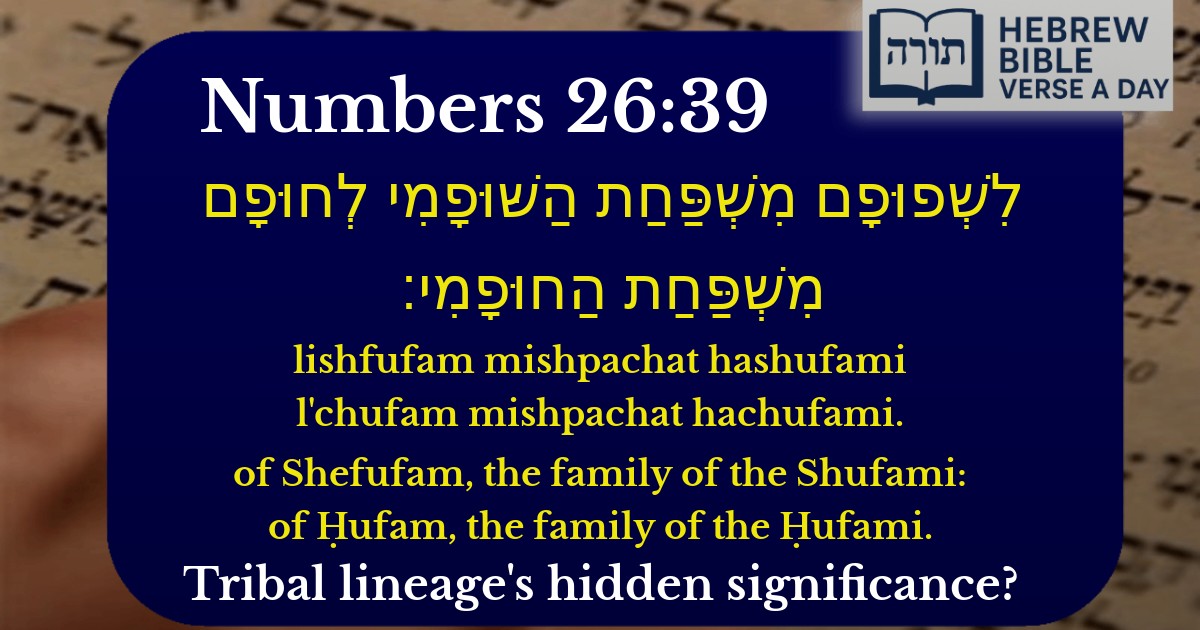Frequently Asked Questions
Q: What is the meaning of Numbers 26:39?
A: Numbers 26:39 lists two families descended from Binyamin (Benjamin) during the census in the wilderness: the Shufami family (from Shefufam) and the Ḥufami family (from Ḥufam). This verse is part of the detailed genealogical record of the tribes of Israel, showing the importance of lineage in Jewish tradition.
Q: Why does the Torah list family names like Shufami and Ḥufami?
A: The Torah lists family names to preserve the identity and heritage of each Israelite tribe. According to Rashi and other commentators, these records ensured proper land inheritance in Eretz Yisrael (the Land of Israel) and maintained the tribal structure, which was essential for spiritual and communal life.
Q: What can we learn from the census in Numbers 26?
A: The census teaches us the value of every individual in the Jewish people. Each family and tribe had a unique role, as emphasized by the Rambam (Maimonides). The detailed counting also highlights Divine providence—Hashem knows and cares for each person’s place within the nation.
Q: Do the family names in Numbers 26:39 have significance today?
A: While these specific family names are not commonly used today, the principle of preserving Jewish lineage remains vital in Orthodox Judaism. Names and ancestry connect us to our heritage, as seen in customs like naming children after ancestors and tracing family roots for marriage (yichus).
Q: How does this verse relate to the rest of Numbers 26?
A: Numbers 26 documents the second census of the Israelites before entering the Promised Land. Verse 39 is part of the tribe of Binyamin’s listing, showing its subdivisions. The Talmud (Bava Batra 109b) explains that such records ensured fair land distribution, fulfilling Hashem’s promise to Avraham’s descendants.


Context in Sefer Bamidbar
The verse (Bamidbar 26:39) appears in the census of Bnei Yisrael taken in the plains of Moav before entering Eretz Yisrael. It lists the descendants of Binyamin through his son Bela, specifically mentioning the families of Shefufam and Chufam.
Grammatical and Textual Analysis
Rashi notes that the names "Shefufam" and "Chufam" appear in a slightly different form earlier in Sefer Bamidbar (3:21) as "Shufam" and "Chupam." He explains that these variations reflect the fluidity of family names over time, a common phenomenon in genealogical records. The suffix "-i" (as in "HaShufami" and "HaChufami") denotes familial affiliation, meaning "the family of Shufam" and "the family of Chufam."
Midrashic Insights
Halachic Significance
The Rambam (Hilchos Kiddush HaChodesh 5:3) references such genealogical lists when discussing the importance of maintaining accurate tribal lineage, particularly for matters like inheritance and yerushah (the division of Eretz Yisrael). The meticulous recording of families underscores the Torah's emphasis on preserving tribal identity.
Chassidic Perspective
The Sefas Emes (Parashas Pinchas) teaches that each family name reflects a unique spiritual quality. "Shufam" and "Chufam" represent distinct paths in avodas Hashem—one through outward action (shinui, change) and the other through inner devotion (chofif, yearning)—both necessary for Klal Yisrael's completeness.